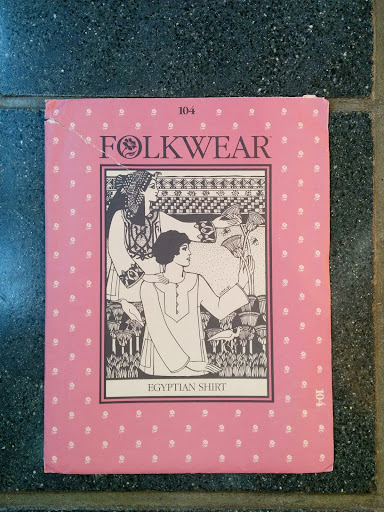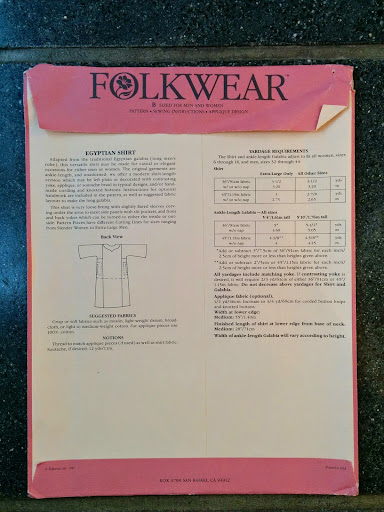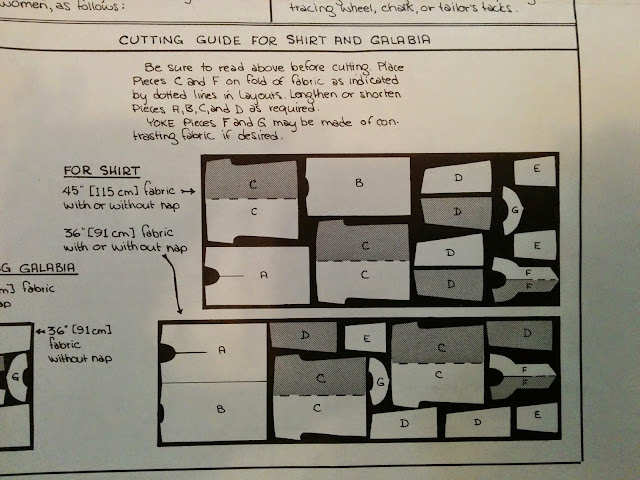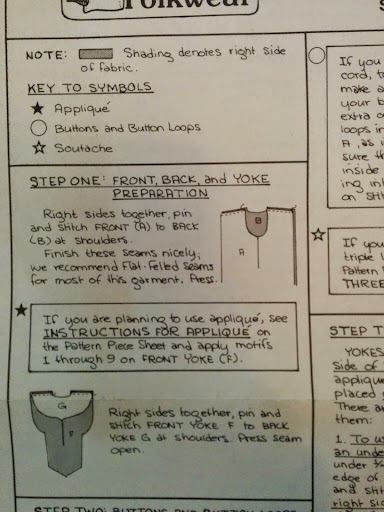First up today is reading and navigating a commercial pattern. Let’s start with the information that’s available without opening it up. While not the “official” sew-along pattern, I’m going to use the Folkwear Egyptian Shirt pattern for these introductory posts as I’ve made two of these recently and some folks were interested in tackling it. It’s also a very straightforward pattern so it’s good for a simple tutorial. Plus, it’s an excuse for me to make another. First, the front:

The pictures on the front of the pattern represent all the versions of the garment that can be made from the included pieces. For shirts/tops, you can generally vary sleeve length/type, collar (add/remove) and other embellishments – like pockets, yokes or otherwise. In this case, you can see two garment styles depicted, one with applique and one without, so that gives you an idea of what’s inside.
Now, the back:

My copy is an old one (dated 1988) so it may differ slightly from the newer versions, but what matters is the the information given, which is typical for printed patterns. First off, on the left hand side, the package describes the garment and the different versions available (all these come on the same pattern layout, as you’ll see later) as well as some information about how the garment fits along with notions (buttons, zippers, snaps, etc.) and recommended fabrics. The publisher’s fabric list is a great starting point when you go shopping – and, if you stick to the recommended list, you shouldn’t have any problems with seam allowances or the way the garment hangs. Another bonus is that if you’re not familiar with the fabrics listed, it’ll give you a chance to learn about new materials and structures.
Next, on the right hand side, there’s a chart that tells you how much fabric you’ll need for a given size, based on the width of the fabric you’re purchasing, as well as any additional fabrics you’ll need – contrasting/coordinating fabric for trim (in this case, appliqué), interfacing (not needed here but often used for button bands, facings and collars).

One thing to keep in mind (and most patterns will state this) – if you’re buying material that has a directional pattern, like plaids, large-scale checks, or asymmetrical stripes, the pattern will recommend you buy additional material. My guideline would be an additional 1/2 yard – up to a full yard if the patterns are really big. Matching patterns at seams requires additional material because you won’t simply butt pieces against each other; rather, you’ll have to orient them on the fabric so that a particular stripe, for example, lands in the same place along the body. Matching patterns is a personal choice, but it makes a big difference in the look of the piece. For your first few patterns, I’d recommend starting off with solids because there’s one less thing to worry about in terms of piece alignment and seaming. So, without even opening the pattern, you’ve got a built-in shopping list. Last note – when buying your fabric, make a note of the care instructions that are printed on the bolt so that you’ll be able to refer to them later.
Now it’s time to open it up and have a look at what’s inside.

You should find a sheet (or sheets) of tissue or pattern paper (modern patterns print their pieces on tissue paper; my Folkwear pattern uses heavy paper stock) and a sheet (or multiple sheets) of instructions. Go ahead and grab the instruction sheet – that’s the smaller one in the upper right.
Always start by reading the instructions through, all the way from start to finish. I cannot stress this enough. By reading the instructions, you’ll get an idea of how the pieces are assembled, what techniques are used (special seam finishes, gathers/pleats, linings), which pieces you need to cut out for the version you’re making (and which ones you don’t need!) and other places that instructions and notes are given. The instruction sheet for this pattern is double-sided; the front has general notes and prep work like fabric finishing, places where you can easily alter to change the fit and the cutting guide:

As you can see, there are two versions of the layout – one for a narrower fabric, one for wider. Now, some of the pieces are dark grey, others are white. If you’re wondering what that means, have a look at the other side of the instruction sheet, where you’ll find this:

See that first note? “Shading denotes right side of fabric.” That’s not only important when it comes to cutting (the pieces that are two-colored are cut on the fold) but it also means that some of the pieces you’re cutting will be turned over. If your fabric has a true “Right” and “Wrong” side (printed patterns vs. woven ones), it’s important to pay attention how you’re placing the pattern pieces when cutting. I’ll cover this in more detail when I do the cutting post, but it’s something to look for when you’re getting oriented with the pattern.
Ok, you’ve read the instructions through, now it’s time to have a look at the pattern sheet. Generally, there’ll only be one, possibly two, sheets that have pieces printed on them regardless of the number of variations or sizes available. And, each pattern piece will have multiple lines for cutting. You can see that here, on the “Side Panel”:

See all those lines on the left hand side of the pattern pieces? The ones with the double diamonds on them? Those are the cutting lines for the different pattern sizes. If you look closely, you’ll see that each line is labeled with it’s associated size. Take the time to find all the pieces you’ll need for your project and how many of each you’ll need to cut (see the “cut four”?). Again, I’ll share some things I do when cutting to help me keep track of pieces and ensure that I’ve cut everything when I write that post.
The last thing is a little more pre-cutting prep. It’s only one thing, but it’s critical – WASH YOUR FABRIC! When it comes off the bolt, at a minimum, it’s dusty from being on a shelf. In addition, it probably still has oils and other surface treatments from the manufacturing process on it – most mills don’t do any kind of fabric finishing before putting the fabric on bolts so that means the fabric is going to shrink and move as soon as it hit water. If you don’t wash the fabric before cutting, you’re going to get an unpleasant surprise after you wash your finished piece. So, pull out those notes you took when buying your fabric and get it clean. As an aside, if your pattern calls for interfacing, that should also be pre-washed. I do it in hot tap water and a bit of dish soap. Interfacing will also tend to shrink a bit when washed and not pre-shrinking before bonding can result in puckers in the finished piece. After the fabric is clean, get out your trusty iron and press it. Then, hang it up (preferably over a round bar so that you don’t put creases in again) and let it rest overnight so that it can relax.
Quick addendum – I was asked if the fabric should be wet, dry, or somewhere “in between” when pressing. The short and ideal answer is that the fabric should be barely damp when you press it; but, it’s ok if the fabric is fully dry – it just means you may well need steam to remove any creases. As for how to dry the fabric, refer to the care instructions you copied down from the bolt as well as your common sense. A good guideline is to treat the fabric no more harshly than you plan to treat the garment. If you plan to hang/air dry, do that. Commercial cottons, linens and poly/cotton blends do fine in the dryer in my experience. Also, be sure to set the heat on your iron to correspond to your fabric type! Refer to your iron’s instruction manual to find the proper setting.
Next step, we cut!
